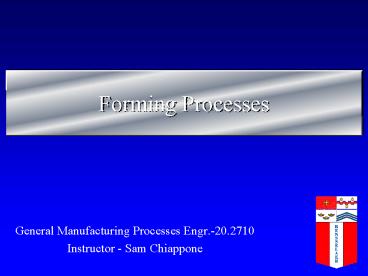Forming Processes - PowerPoint PPT Presentation
1 / 27
Title:
Forming Processes
Description:
Forming processes are one of the most popular means of producing ... Used primarily for cylindrical work involving seaming, flanging, riveting, and embossing ... – PowerPoint PPT presentation
Number of Views:84
Avg rating:3.0/5.0
Title: Forming Processes
1
Forming Processes
- General Manufacturing Processes Engr.-20.2710
- Instructor - Sam Chiappone
2
Metal Forming/Press Operations
- Forming processes are one of the most popular
means of producing high volume products.
Examples include appliance, aircraft, and
automotive industries. - Major Reasons
- Production costs are low
- Well suited for high production applications
- Process capabilities
- Processes are built into tooling
3
Tools
- One of the basic tools used in these processes is
a punch die. - A punch is the portion of the tool attached to
the ram of the press and is inserted into the
die. - A die is usually the stationary portion of the
tool attached to the press bed. It has a cavity
to accept the punch.
4
Tools
- Punch die
5
Tools
- A progressive die is a tool capable of performing
several operations from raw material to final
product. These dies can be made from catalog
items and divided into removable sections.
6
Tools
- Die alignment and clearance
- Uniform clearance
- General rule - 5-7 material thickness
7
Tools
- Punch dies are capable of performing the
following examples of cold working(CW)
operations - Blanking - cutting desired shape from strip,
burrs left on strip - Piercing - leaving desired shape on strip, burrs
on scrap
8
Tools
- Punch die capabilities continued
- Forming Bending
- Shearing
- Ironing
- Drawing
9
Process Capabilities
- Blanking vs. Piercing
10
Tools
- Forming Bending
11
Tools
- Shearing
12
Tools
- Ironing
13
Process Capabilities
- Drawing
14
Calculating Pressure for a Process (Tons)
- General formula for a hole
- Diameter of hole x Thickness of material x
Ultimate Tensile Strength (UTS) Pressure in
Tons - Guidelines
- Mild Steel 80 - 60,000 psi, Brass 60,000 psi,
- Bronze 40,000 psi, Copper 30,000 psi
- Alum 20,000 psi
- Example
- 2 dia. hole in ¼ steel plate
- 2 x .250 x 80 40 tons
15
Calculating Pressure for a Process (Tons)
- General Formula - Profile
- P (L x 1/3) x material thickness x 60 (UTS)
- Example Punch a 1x 2 rectangle in ¼ brass
- P (6 x 1/3) x .250 x 60 29.7 30 tons
- Machinerys Handbook 23rd Edition
16
Progressive Dies
17
Progressive Dies
18
Machine Tools- Presses
- Classification
- Manual
- Foot operated
- Light work -shearing
19
Machine Tools- Presses
- Mechanical
- Max pressure near bottom of stroke
- Faster motion
- Operations - cutting, shallow forming, drawing,
and progressive die operations - Limitation - length of stroke set by design of
mechanism less flexibility - Capacities up to 6,000 tons
20
Machine Tools- Presses
- Mechanical Press Drive Mechanisms
- Crank Simple design - used for piercing,
blanking, and drawing operations - Eccentric/Cam Short ram stroke which provides a
dwell a bottom of stroke - Knuckle
- Fast action and high mechanical advantage
- Applications include coining and sizing
- Toggle Drawing presses to move the blank holder
- Screw Slow action
21
Machine Tools- Presses
- Hydraulic
- Motion as a result of piston motion longer or
variable stroke lengths can be programmed (within
limitations of the piston). - Steady pressure for operations such as deep
drawing - Single-slide
- Multiple-slide
- Capacities up to 50,000 tons
22
Machine Tools- Presses
- Frame classification
- Gap
- Open arrangement of press frame
- Excellent clearance around dies
- Can handle long and wide parts
- Arch
- Lower portion of press near the bed is wide to
accommodate large sheet material
23
Machine Tools- Presses
- Frame classification continued
- Straight side
- Strong frame designheavy loads are taken up in
vertical direction of massive frame - Less of a tendency for punch die to misalign
- Horn
- Heavy shaft projecting from frame
- Used primarily for cylindrical work involving
seaming, flanging, riveting, and embossing
24
Machine Tools- Presses
- Frame classification continued
- Inclined
- Vertical design can be tilted back to allow parts
and scrap to slide out - Used on parts involving bending, piercing,
blanking, etc. - Turret Presses
- Production of sheet metal parts having a variety
of patterns, holes, cutouts, etc. in various
sizes - Current presses are CNC controlled and combined
into machining centers, capable of laser,
forming, and water-jet operations.
25
Machine Tools- Presses
- Frame classification continued
- Four Slide
- Complex forming of small to medium size parts
- Machine Basics
- 4-slides at 90 degrees controlled by cam to
progressively move through a cycle to achieve a
final part - Can be tooled with punches, cut-off tools,
lifting/shifting tools, and welding systems.
26
Machine Tools- Presses
- Frame classification
27
Machine Tools- Presses
- Accessories































